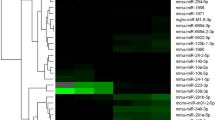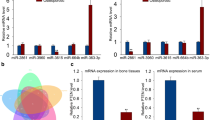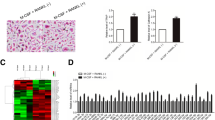Abstract
MicroRNAs (miRNAs) modulate gene expression and regulate many physiological and pathological conditions. However, their modulation and effect in osteoclastogenesis remain unknown. In this study, we investigated the role of miR-346-3p in regulating the osteoclast differentiation from RAW264.7 cells. We used the miRNA microarray assay, miR-346-3p mimic transfection, tartrate resistant acid phosphatase (TRAP) staining, bone resorption assay, qRT-PCR, and western blot. Our results showed that the expression of miR-346-3p was significantly upregulated during osteoclast differentiation. Further, by transfecting cells with miR-346-3p mimic, we observed an increased number of TRAP-positive multinucleated cells, increased pit area caused by bone resorption, and enhanced expression of osteoclast-specific genes and proteins. Conversely, miR-346-3p inhibition attenuated the osteoclast differentiation and function. Software-mediated prediction and validation using luciferase reporter assay showed that TRAF3, a negative regulator of osteoclast differentiation, was inhibited by miR-346-3p overexpression. Our results showed that miR-346-3p directly targeted TRAF3 mRNA via binding to its 3′-UTR and inhibited the expression of TRAF3 protein. Taken together, our results revealed that miR-346-3p promotes the regulation of osteoclastogenesis by suppressing the TRAF3 gene. In conclusion, miR-346-3p could be a novel therapeutic target for bone loss-related pathogenesis.







Similar content being viewed by others
References
Boyce BF (2013) Advances in osteoclast biology reveal potential new drug targets and new roles for osteoclasts. J Bone Miner Res 28:711–722
Boyle W, Simonet W, Lacey D (2003) Osteoclast differentiation and activation. Nature 423:337–342
Chen X, Wang Z, Duan N, Zhu G, Schwarz EM, Xie C (2018) Osteoblast-osteoclast interactions. Connect Tissue Res 59:99–107
Ghosh S, Karin M (2002) Missing pieces in the NF-kappaB puzzle. Cell 109:S81–S96
Gravallese E, Galson D, Goldring S, Auron P (2001) The role of TNF-receptor family members and other TRAF-dependent receptors in bone resorption. Arthritis Res 3:6–12
Guo Z, Li J, Sun J, Sun L, Zhou Y, Yu Z (2018) miR-346 promotes HCC progression by suppressing breast cancer metastasis suppressor 1 expression. Oncol Res 26:1073–1081
Hayden MS, Ghosh S (2008) Shared principles in NF-kappaB signaling. Cell 132:344–362
Hrdlicka HC, Lee SK, Delany AM (2019) MicroRNAs are critical regulators of osteoclast differentiation. Curr Mol Biol Rep 5:65–74
Hu CH, Sui BD, Du FY, Shuai Y, Zheng CX, Zhao P, Yu XR, Jin Y (2017) miR-21 deficiency inhibits osteoclast function and prevents bone loss in mice. Sci Rep 7:43191
Kitazawa R, Haraguchi R, Fukushima M, Kitazawa S (2018) Pathologic conditions of hard tissue: role of osteoclasts in osteolytic lesion. Histochem Cell Biol 149:405–415
Krzeszinski JY, Wei W, Huynh H, Jin Z, Wang X, Chang TC, Xie XJ, He L, Mangala LS, Lopez-Berestein G, Sood AK, Mendell JT, Wan Y (2014) miR-34a blocks osteoporosis and bone metastasis by inhibiting osteoclastogenesis and Tgif2. Nature 512:431–435
Li J, Ayoub A, Xiu Y, Yin X, Sanders JO, Mesfin A, Xing L, Yao Z, Boyce BF (2019) TGFbeta-induced degradation of TRAF3 in mesenchymal progenitor cells causes age-related osteoporosis. Nat Commun 10:2795
Lian JB, Stein GS, van Wijnen AJ, Stein JL, Hassan MQ, Gaur T, Zhang Y (2012) MicroRNA control of bone formation and homeostasis. Nat Rev Endocrinol 8:212–227
Lin CW, Jan MS, Kuo JH (2015) Exploring MicroRNA expression profiles related to the mTOR signaling pathway in mouse embryonic fibroblast cells treated with polyethylenimine. Mol Pharm 12:2858–2868
Lozano C, Duroux-Richard I, Firat H, Schordan E, Apparailly F (2019) MicroRNAs: key regulators to understand osteoclast differentiation? Front Immunol 10:375
Niu D, Gong Z, Sun X, Yuan J, Zheng T, Wang X, Fan X, Mao Y, Liu X, Tang B, Fu Y (2019) miR-338-3p regulates osteoclastogenesis via targeting IKKbeta gene. In Vitro Cell Dev Biol Anim 55:243–251
Okamoto K, Nakashima T, Shinohara M, Negishi-Koga T, Komatsu N, Terashima A, Sawa S, Nitta T, Takayanagi H (2017) Osteoimmunology: the conceptual framework unifying the immune and skeletal systems. Physiol Rev 97:1295–1349
Ono T, Nakashima T (2018) Recent advances in osteoclast biology. Histochem Cell Biol 149:325–341
Park JH, Lee NK, Lee SY (2017) Current understanding of RANK signaling in osteoclast differentiation and maturation. Mol Cells 40:706–713
Shibuya H, Nakasa T, Adachi N, Nagata Y, Ishikawa M, Deie M, Suzuki O, Ochi M (2013) Overexpression of microRNA-223 in rheumatoid arthritis synovium controls osteoclast differentiation. Mod Rheumatol 23:674–685
Taganov KD, Boldin MP, Chang KJ, Baltimore D (2006) NF-kappaB-dependent induction of microRNA miR-146, an inhibitor targeted to signaling proteins of innate immune responses. Proc Natl Acad Sci U S A 103:12481–12486
van Dam PA, Verhoeven Y, Trinh XB, Wouters A, Lardon F, Prenen H, Smits E, Baldewijns M, Lammens M (2019) RANK/RANKL signaling inhibition may improve the effectiveness of checkpoint blockade in cancer treatment. Crit Rev Oncol Hematol 133:85–91
VanArsdale T, VanArsdale S, Force W, Walter B, Mosialos G, Kieff E, Reed J, Ware C (1997) Lymphotoxin-beta receptor signaling complex: role of tumor necrosis factor receptor-associated factor 3 recruitment in cell death and activation of nuclear factor kappaB. Proc Natl Acad Sci U S A 94:2460–2465
Yang C, McCoy K, Davis J, Schmidt-Supprian M, Sasaki Y, Faccio R, Novack D (2010) NIK stabilization in osteoclasts results in osteoporosis and enhanced inflammatory osteolysis. PLoS One 5:e15383
Yang F, Luo LJ, Zhang L, Wang DD, Yang SJ, Ding L, Li J, Chen D, Ma R, Wu JZ, Tang JH (2017) MiR-346 promotes the biological function of breast cancer cells by targeting SRCIN1 and reduces chemosensitivity to docetaxel. Gene 600:21–28
Yao Z, Xing L, Boyce BF (2009) NF-kappaB p100 limits TNF-induced bone resorption in mice by a TRAF3-dependent mechanism. J Clin Invest 119:3024–3034
Zhao B (2018) Does TNF promote or restrain osteoclastogenesis and inflammatory bone resorption? Crit Rev Immunol 38:253–261
Zhao K, Jia Y, Peng J, Pang C, Zhang T, Han W, Jiang J, Lu X, Zhu J, Qian Y (2019) Anacardic acid inhibits RANKL-induced osteoclastogenesis in vitro and prevents ovariectomy-induced bone loss in vivo. FASEB J 33:9100–9115
Acknowledgements
We would like to appreciate lab members for their support to our research and thank Editage (www.editage.cn) for English language editing.
Funding
This study was supported by grants from the National Natural Science Foundation of China (31700854), the Project of Natural Science Foundation of Anhui Province (1908085MH276), the Key Program of Anhui Educational Committee (KJ2018A1011 and KJ2019A0392), the Scientific Research Foundation of Bengbu Medical College (BYKY17118, BYKY18108, and BYKY1848ZD), the Translational Medicine Key Projects of Bengbu Medical College (BYTM2019006 and BYTM2019012), the Scientific Research Innovation Team of Bengbu Medical College (BYKC201910), the Postgraduate Research Innovation Project of Bengbu Medical College (Byycx1827, Byycx1954, Byycx1956, and Byycz1929), and the National Training Programs of Innovation and Entrepreneurship for Undergraduate (201810367013 and 201810367028).
Author information
Authors and Affiliations
Corresponding author
Ethics declarations
Conflict of interests
The authors declare that they have no competing interests.
Additional information
Editor: Tetsuji Okamoto
Rights and permissions
About this article
Cite this article
Mao, Y., Chen, Y., Fu, Y. et al. miR-346-3p promotes osteoclastogenesis via inhibiting TRAF3 gene. In Vitro Cell.Dev.Biol.-Animal 56, 533–542 (2020). https://doi.org/10.1007/s11626-020-00479-w
Received:
Accepted:
Published:
Issue Date:
DOI: https://doi.org/10.1007/s11626-020-00479-w




